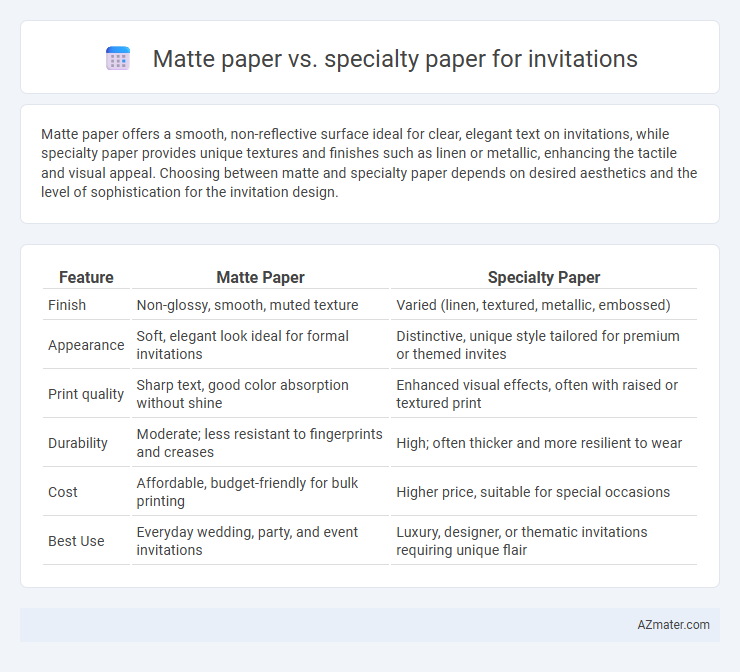Matte paper offers a smooth, non-reflective surface ideal for clear, elegant text on invitations, while specialty paper provides unique textures and finishes such as linen or metallic, enhancing the tactile and visual appeal. Choosing between matte and specialty paper depends on desired aesthetics and the level of sophistication for the invitation design.
Table of Comparison
| Feature | Matte Paper | Specialty Paper |
|---|---|---|
| Finish | Non-glossy, smooth, muted texture | Varied (linen, textured, metallic, embossed) |
| Appearance | Soft, elegant look ideal for formal invitations | Distinctive, unique style tailored for premium or themed invites |
| Print quality | Sharp text, good color absorption without shine | Enhanced visual effects, often with raised or textured print |
| Durability | Moderate; less resistant to fingerprints and creases | High; often thicker and more resilient to wear |
| Cost | Affordable, budget-friendly for bulk printing | Higher price, suitable for special occasions |
| Best Use | Everyday wedding, party, and event invitations | Luxury, designer, or thematic invitations requiring unique flair |
Introduction to Invitation Paper Types
Matte paper offers a smooth, non-reflective finish ideal for elegant and understated invitations, enhancing readability and providing a classic look. Specialty paper includes textured, metallic, or translucent options that add unique tactile and visual effects, perfect for creating memorable and distinctive invitations. Choosing between matte and specialty papers depends on the desired aesthetic and the formality of the event.
What Is Matte Paper?
Matte paper offers a non-glossy finish that reduces glare and fingerprints, making it ideal for elegant and understated wedding or event invitations. This type of paper enhances color vibrancy and readability, providing a smooth texture that adds a professional touch to printed designs. Specialty paper, by contrast, includes unique finishes like textured, metallic, or recycled options, catering to more creative or thematic invitation styles that require a distinct aesthetic beyond the classic matte appearance.
What Is Specialty Paper?
Specialty paper for invitations encompasses unique materials like textured, metallic, pearlescent, or handmade finishes designed to create a distinct tactile and visual experience. Unlike matte paper, which offers a smooth, non-reflective surface ideal for minimalistic and elegant designs, specialty papers enhance the invitation's aesthetic appeal with intricate fibers, embossing, or shimmer effects. Choosing specialty paper elevates the overall impression of invitations, making them standout keepsakes perfect for weddings, corporate events, or personalized celebrations.
Appearance and Texture Comparison
Matte paper offers a smooth, non-reflective surface that enhances readability and gives invitations a classic, understated elegance. Specialty paper includes a variety of textured options such as linen, cotton, or embossed finishes, providing a tactile richness and visual depth that elevate the invitation's uniqueness. While matte paper emphasizes simplicity and muted sophistication, specialty paper stands out through intricate textures and luxurious feel, making each invitation distinctly memorable.
Print Quality and Color Vibrancy
Matte paper offers a smooth, non-reflective surface that enhances print clarity and reduces glare, ensuring text and images remain sharp and readable for invitations. Specialty paper, often textured or coated with unique finishes, provides richer color vibrancy and depth, making designs stand out with added visual appeal and tactile interest. The choice between matte and specialty paper directly impacts print quality, with matte favoring subtle elegance and specialty paper amplifying color intensity and creative expression.
Durability and Handling
Matte paper offers moderate durability with a smooth, non-reflective surface that resists fingerprints and smudges, making it easy to handle and write on for invitations. Specialty paper, such as textured, metallic, or handmade varieties, provides enhanced durability through thicker weights and unique finishes, but may require careful handling due to delicate surfaces or embellishments. Selecting between matte and specialty paper depends on balancing the desired elegance and the need for robustness during mailing and handling processes.
Suitability for Different Invitation Styles
Matte paper offers a smooth, non-reflective finish ideal for classic and elegant invitation styles, providing a subdued and sophisticated look that enhances detailed typography and minimalist designs. Specialty paper, including textured, metallic, or translucent options, caters to unique and creative invitations, adding tactile interest and visual appeal suited for themed or high-impact events. Choosing between matte and specialty paper depends on the desired aesthetic and formality, with matte favoring timeless elegance and specialty paper enabling distinct, personalized invitations.
Cost Differences and Budget Considerations
Matte paper offers an affordable option for invitations, with prices typically ranging from $0.10 to $0.50 per sheet, making it suitable for large-volume printing within a tight budget. Specialty papers, such as textured, metallic, or handmade types, often cost between $0.75 and $3.00 per sheet due to unique finishes and higher quality materials, which can significantly increase overall invitation expenses. When budgeting, consider the scale of the event and desired aesthetic, as choosing specialty paper can enhance visual impact but may require allocating a larger portion of funds to printing materials.
Environmental Impact and Sustainability
Matte paper for invitations often features a smooth, non-glossy finish and is typically produced using recycled fibers, making it a more eco-friendly choice with lower environmental impact. Specialty papers, including handmade, textured, or metallic varieties, tend to have higher resource consumption and may involve non-recyclable coatings, resulting in reduced sustainability. Choosing matte paper with certified eco-labels such as FSC or recycled content supports sustainable sourcing and waste reduction in invitation printing.
Choosing the Best Paper for Your Invitations
Matte paper offers a smooth, non-glossy finish that enhances readability and provides a classic, elegant look ideal for formal invitations, while specialty paper includes textured or decorative options like linen, cotton, or metallic finishes that add unique visual and tactile appeal. The choice depends on the event tone and personal style: matte paper suits minimalist and sophisticated designs, whereas specialty paper elevates artistic, luxurious, or themed invitations. Consider durability, print quality compatibility, and budget to select the best paper that effectively conveys your invitation's message and aesthetic.

Infographic: Matte paper vs Specialty paper for Invitation
 azmater.com
azmater.com